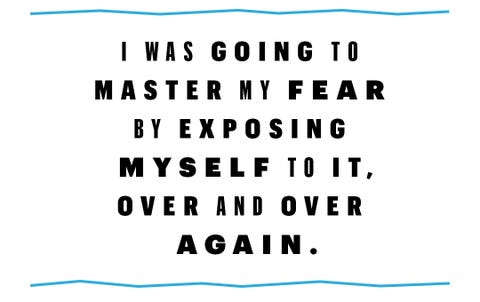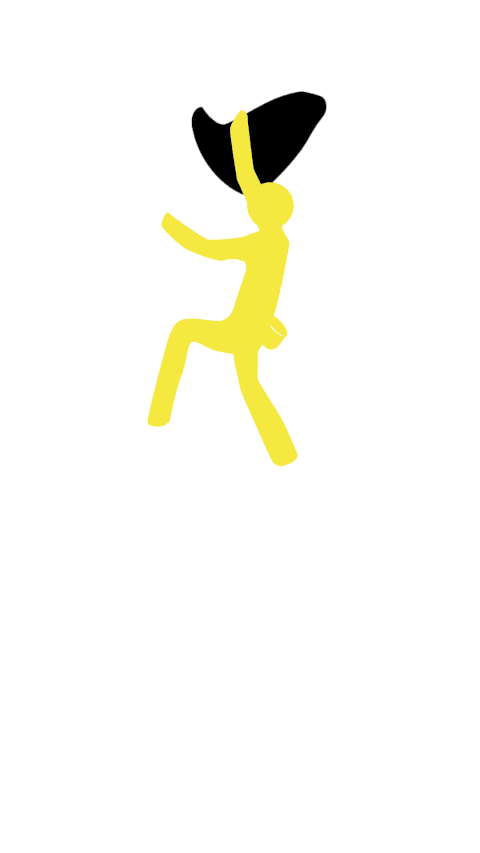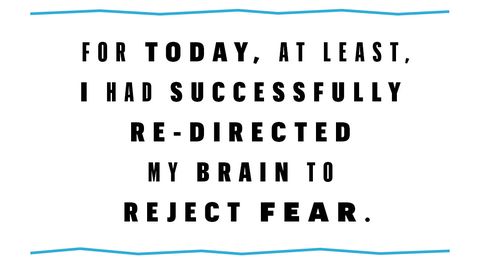Exposure Therapy and the Fine Art of Scaring the Out of Yourself on Purpose
The panic grew with every move I fabricated: gripping small handholds with suddenly sweaty palms, placing my soft prophylactic-soled climbing shoes onto small ledges and nubs in the granite face up. My chest seized upwardly; the fear gripping my lungs and my brain made me dizzy. I breathed loud and fast through my oral cavity. My encephalon screamed warnings at my torso:
Information technology was an early May evening at the Rock Gardens, a popular climbing crag in Whitehorse, the small capital city of the Yukon Territory, where I live. By attempting to climb a steep stone wall, I was deliberately terrorizing myself, creating a situation I knew would induce something similar to a panic attack. Simply if I could learn to be less afraid while harnessed upward and clinging to a rock face, I had decided, I might learn to control my debilitating fear of heights more more often than not.
That dark, I managed to force my manner six or seven feet up a 20-six-foot road before I begged my climbing partner, belaying me from below, to lower me downward. As my feet touched the ground, I tried to command my panting and avoided looking anyone in the middle.
Acrophobia, or extreme fear of heights, is among the almost common phobias in the world: One Dutch report institute that it affects as many as 1 in 20 people. Even more people suffer from a non-phobic fear of heights—they don't come across the bar to be technically diagnosed, but they share symptoms with true acrophobes similar me. All told, equally much every bit 20-eight per centum of the general population may have some tiptop-induced fear.
Plenty of people work around acrophobia, but avoiding triggering situations. Just seven and a half years ago, I moved to the Yukon, where many people spend their time hiking up steep mountains, climbing rock walls and frozen waterfalls, pinballing down mountain biking trails. My fear became a true liability—an obstacle between me and new friends, new hobbies, a new lifestyle. During my first full summertime in Whitehorse, I panicked twice on hiking trails, crimper upwards on the ground and refusing to movement at all, or creeping along Gollum-like, on all fours, while anybody around me walked upright. It was intolerable.
So last summertime, I formulated a plan: I'd use the latest research to build myself a DIY cure—or, at the very to the lowest degree, a coping mechanism. I was going to master my fear past exposing myself to information technology, over and over once more.
"Confront your fears" is an old idea. Even its modern, clinical variation—the thought that, as a 1998 paper in the Journal of Consulting and Clinical Psychology put it, "emotional engagement with traumatic memory is a necessary status for successful processing of the issue and resultant recovery"—dates back more than a century, to the work of Pierre Janet and Sigmund Freud. Just its codification, therapeutic application is much more recent, and information technology has important implications non just for people with phobias, only those dealing with all sorts of anxiety-based conditions, from obsessive-compulsive disorder to PTSD. Facing one'due south fears, washed correctly, could be a way forwards for tens of millions of people whose anxieties control them.
I based my goals and methods of my DIY therapy program on the concept of "exposure therapy," a concept that owes its existence largely to Israeli psychologist Edna Foa, at present the managing director of the Academy of Pennsylvania's Middle for the Treatment and Study of Anxiety. As a post-doctoral fellow at Temple University in the early on 1970s, Foa trained under Dr. Joseph Wolpe, the male parent of what was then known equally systematic desensitization. Wolpe's piece of work involved exposing phobic or broken-hearted patients to the sources of their fears, mostly using "imaginal" exposure—for instance, having an arachnophobic patient imagine a spider at a distance, and and so imagine the spider slightly closer, and then on—combined with relaxation techniques.
Foa's innovation was investigating whether a greater degree of "in vivo" exposure—exposure to the real fright stimulus, not merely an imagined one—could better on Wolpe'south promising results. Before researchers had assumed such direct exposure could be dangerous for patients with phobias and anxiety disorders, merely the science on that forepart was changing. "I started to do studies of exposure in vivo, starting not with the highest level of fearfulness only with moderate levels, and going faster, proceeding to college and college situations that evoke college and higher anxiety," Foa told me. The results, she said, were "excellent."
Exposure therapy is basically an inversion of a well-known psychological technique known as classical conditioning. If y'all tin teach an animate being to expect pain from, say, a blinking scarlet light by repeatedly combining the light's appearance with an electrical shock until the animal reacts fearfully to the light solitary, it makes sense that the twinning of stimulus and fear tin can be unraveled too. Show the animal the red calorie-free plenty times without an accompanying shock, and eventually information technology will no longer fear the calorie-free—a process known every bit extinction. I was determined to extinguish my fear by proving to myself that I could climb a cliff.
If I was afraid of heights equally a pocket-size child, I don't retrieve information technology. I never climbed trees, and I was uncomfortable when my friends and I clambered upwards to sit down on superlative of the monkey confined on the playground. But I was a timid kid in general—I once told my mom that I never ran as fast equally I could in schoolhouse races, for fear of losing control and falling—so all that was of a piece with my personality at that fourth dimension.
In my first clear memory of feeling afraid of heights—not simply afraid, simply terrified—I am fifteen years old. It was the summer afterward 9th grade, and I'd signed upward to spend a calendar week sailing on an old-fashioned transport on Lake Ontario with a dozen other teens. I loved everything nearly life on board that transport: sleeping in my narrow metal bunk below deck; waking in the middle of the dark to stand lookout, peering out at the endless darkness; lounging on sunny afternoons in the net that hung beneath the carved bow. On deck, we wore harnesses around our chests, fitted with a short rope catastrophe in a heavy metal clip. In very rough weather, or if we were climbing the mast to adjust the sails, we were meant to clip ourselves in, simply in case.
The problem came the first time I tried to climb the mast—to "go aloft," in sailing terminology. I got partway up, moving my clip as I went, fighting panic with each step on the ladder-like holds. Then I froze. I couldn't stop staring at the wooden deck swaying below me, couldn't cease picturing my body splattering against it, my bones shattering, my claret running into the lake.
The transport'southward "officers"—our army camp counselors—managed to coax me down, and I never went aloft again. Everyone was kind to me nearly my failure, but in that location was no indicate in coming back the following yr. A sailor who can't adapt the sails in a compression isn't much use.
After that, my fear went dormant again for near a decade. It resurfaced afterwards grad school, while I was backpacking with friends in Europe. I'd adult a fascination with the art and architecture of old churches, and nosotros hit cathedral subsequently cathedral beyond the southern half of the continent. We visited a few cupolas, and I gritted my teeth going upwards and downward the narrow stone stairways. But I didn't truly panic until Florence.
I'd made information technology to the peak of the legendary Duomo and was animate securely, trying to stay calm and bask myself as I looked out over the city'southward terracotta rooftops. The famous steep cerise dome of the cathedral curved away below me, and as I glanced down at it, suddenly all I could think most was how information technology would feel to tumble over the flimsy metal railing in front of me, to slide down over those reddish tiles toward the driblet-off. I couldn't exhale.
The viewing platform was crowded with tourists. I pushed through them to the wall and slid down with my back against it, put my head between my knees to cake out the view, and hyperventilated through my tears. My friends establish me at that place, somewhen talked me to my anxiety, and held my hands while we inched back down the twisting staircase to safety and solid ground. We didn't visit whatever more than cathedral towers after that.
In the years since that humiliating incident, I've tried to figure out why I react to heights—specifically exposed heights; I'1000 generally fine in enclosed spaces, like elevators and airplanes—the manner I do. Phobias can oftentimes derive from traumatic experiences, or even observations of others' traumatic experiences, early in life. But it turns out that the acrophobia is different. If I'm anything like the subjects of recent research, I accept measurably sub-par control over my body's movement through space, also as an over-dependence on visual cues—which are distorted by heights—to manage my movement through the globe. In other words, I am afraid of falling from heights because I am more likely than other people to fall from heights.
For a 2014 newspaper in the Journal of Vestibular Enquiry, a squad of German scientists studied the center and head movements of people who are afraid of heights, plus a control group, every bit they looked over a balustrade. They found that their fearful subjects tended to restrict their gazes, locking their heads in place and fixing their optics on the horizon rather than looking down or around at their environment. That description will ring true to anyone who's ever felt afraid of heights, or tried to counsel someone who is: Don't await down. Whatever you do, don't look downward.
So, ironically, I fix my gaze to the horizon as a defense force mechanism confronting my fear, merely because that fear is rooted in my over-reliance on visual cues, restricting my range of vision tin only make things worse. It's a cycle: My brain knows that my trunk is bad at navigating heights, then information technology sends out fear signals every bit a alert. My body shuts downwards in response, which merely increases the likelihood that I will actually harm my klutzy cocky. And thus a once-rational response to a reasonable business organisation feeds on itself, growing and spreading to the indicate where I can hardly stand up on a sturdy stepladder.
A few weeks subsequently that first outing in May, I was back at the Stone Gardens. I'd been making sporadic attempts to face my fears for years, just now I intended to be more systematic about my efforts, and to document them every bit I went.
The route I was attempting was a beginner's climb, laughably like shooting fish in a barrel for most people with any experience. And it came with a cheat option: a detour of a few feet to the right, into a wide crevice betwixt two rock faces made information technology fifty-fifty simpler. Merely to get to the crack and the easiest way upward, I had to make 1 slightly tricky movement. I would have to pace frontwards with my left foot, balance the toe of my shoe on a small-scale nub, shift all my weight briefly to that left toe, then swing my right pes over and across to the next proper ledge—all without any handholds for residuum.
My climbing partner stood below me, holding the other end of the rope that secured me to the bolted metallic anchors at the superlative of the climb. If I roughshod, she would pull down on the rope, stopping me before I'd plummeted more than a pes or two. Climbing on top rope, equally information technology's known, involves most no real risk. But my lungs constricted anyway, and I fought to squelch my dizziness and panic. From the basis, my friends encouraged me: Trust your shoes, trust your feet. This volition be fine. You can do this.
Finally, I took a deep jiff, stepped forward, shifted my weight from one foot to the next and made it beyond. I fumbled above my caput for handholds to steady myself, then grinned and tried to breathe. For a moment while I was in motion, I had felt weightless, in command. Unafraid. Now the fearfulness came seeping back as I connected climbing, scrambling through the loose dirt that had collected on the ledges and lumps of stone in the crevice. I finished the climb, but raggedly, fending off panic the whole way. Information technology was a good outset, but every bit my belayer lowered me back downwardly to the ground, I knew I had a long style to get.
We don't know exactly what happens in the encephalon during the extinction process. As Foa puts it, "is it that you erase the connections" between stimulus and fear, "or that you lot supplant them with a new structure?" Her hypothesis is that exposure therapy trains the brain to create a second, competing structure aslope the traumatic 1. The new structure, she explained, "does not have the fearfulness, and does not take the perception that the world is entirely dangerous and that oneself is entirely incompetent."
That was why my panicked success in the Rock Gardens that twenty-four hour period was really no success at all. I had climbed the wall, certain, but I had failed to convince my brain to build a new structure. Repeatedly terrorizing myself wouldn't solve my fear; it wasn't enough to scramble through with wild optics and a pounding heart. I had to learn to stay calm.
Perhaps the most transformative awarding of exposure therapy is using it not to combat specific phobias, or fifty-fifty broader anxiety-based disorders, merely post-traumatic stress disorder. In 1980, PTSD was included for the first time in the Diagnostic and Statistical Manual of Mental Disorders. In the decades since, our understanding of the disorder has grown, and so has our grasp of its staggering achieve. We at present know that PTSD affects not but soldiers and civilians emerging from war, only also drone operators who've never left their home base; first responders from trounce cops to search-and-rescue volunteers operating out of luxurious mount resorts; survivors of car wrecks, assaults, and less obvious forms of trauma.
But back in the early 1980s, "we didn't have any studies on PTSD," Foa said. "And I thought, well, this is an anxiety disorder, there is no reason why we cannot arrange the treatment, the exposure therapy treatment, to PTSD." You can't re-betrayal someone to a rape or a bomb, so Foa settled on a program of imagined exposure for the traumatic memory itself, but in vivo exposure to the secondary effects: the patient's avoidance behaviors, which can perpetuate trauma's power. In sessions with therapists, patients would face the memory using imaginal exposure. Their "in vivo" exposure came equally homework: going to places that reminded them of the trauma, or to rubber places they perceived as unsafe. Sometimes that meant walking a downtown street at night after a violent attack, or going to malls once again afterwards a mass shooting.
Throughout the 1990s, Foa'southward team taught others groups of therapists how to administer what she called prolonged exposure therapy (or PE), and how to monitor the results. They found that PE was effective in about 80 percent of patients: Between forty and 50 per centum became essentially symptom-gratis, while twenty to thirty pct still had some recurring symptoms but were much improved. "We're non 100 percent successful," she said, "but no treatment is." She launched PE into the wider world with a series of papers in the late '90s, and inside a few years the plan had go the gold standard for treatment of anxiety disorders and PTSD. In 2010, Foa was named 1 of Time's 100 most influential people. "No one is doing more" to finish the suffering caused by PTSD, the magazine alleged.
An estimated eight meg American adults feel PTSD every year. Nineteen million more than deal with specific phobias, half-dozen one thousand thousand with panic disorders, seven million with generalized feet disorder, and more than two 1000000 with OCD. The Feet and Low Association of America estimates that only one-third of anxiety-disordered patients receive treatment. At present, researchers are exploring whether pharmaceuticals tin enhance the effectiveness of exposure therapy, while others have practical variations of PE to grief, depression, eating disorders, and beyond.
Compared to living with PTSD or broader anxiety disorders, my fright of heights is fiddling. It doesn't keep me awake at night, or ruin my relationships, or bleed into every area of my life. If I moved back to the flatlands and avoided high-rise balconies, dodging my symptoms past practicing avoidance, I would hardly observe it.
Still, information technology can limit me. I would have liked to climb that mast high into the rigging, to enjoy the view over Florence. Sometimes I get scared on bridges or balconies, and I have notwithstanding never climbed a tree. Taken individually those are all tiny things, but they add upward to a feeling of helplessness: My choices are not entirely my own.
The stone was cold plenty to numb my fingers. It was October 2, and I was on my eighth and final climbing circuit of the season, earlier winter set in. All summer, I had gone climbing every fourth dimension someone with the necessary expertise and gear was willing to have me along. I had tried to systematize my outings, repeating the same routes to see if I could get farther, and stay calmer, each time.
In previous years, I would have pushed myself until my panic was unbearable, hoping that I could popular it like a lather bubble if only I tried hard enough. But at present my strategy was to go simply every bit far up as I could without paralysis setting in. The goal was to build upwardly the alternate structure in my encephalon that said "This is okay. You lot are safe," so come down earlier the onetime structure could assert itself, and hope to get a pes or two further next time around.
For this last outing, iii friends and I were at Copper Cliffs, a crag in Whitehorse'south semi-industrial backyard: once a booming copper mining expanse, now a maze of quarries and mountain biking trails and pocket-size, shallow lakes. I was climbing Anna Banana, a short, beginner-friendly, xvi-foot route up 1 side of an arête, a precipitous wedge of rock protruding from the main cliff confront. My first steps had been on easy footholds, gaps cutting into the leading point of the wedge, and I had no trouble until my feet were seven and a one-half, eight feet off the basis. I stalled out there, my right human foot resting on a good ledge just effectually the corner of the arête while my left toe was tucked into a lilliputian cubbyhole a human foot below. To continue, I had to pull my left leg upward several feet, to the next skilful agree.
I raised my arms and patted the stone above my head, blindly seeking out handholds that I could use to pull myself up higher, to give my left human foot a fighting chance. I tend to trust my hands and arms first, even though my legs are exponentially stronger: Nosotros're less accustomed to trusting a narrow toehold than a fist clamped around something solid. But I didn't find what I was looking for, then instead I spread my arms out wide and locked my fingers around the best stabilizing holds I could attain. Then I pushed off with all my weight on my right foot, pulled my artillery tight to keep me close to the rock face, and scraped my left foot up the wall until I institute the next hold, just as my right toe lost contact with the rock. I counterbalanced in that location for a moment, then raised my hands to holds suddenly within my reach and pulled up my dangling right human foot.
I had washed information technology. More than importantly, I had done it calmly and coolly, without needing extra minutes to fight off panic, without groaning and moaning before I gave it a try. My belayer lowered me downwardly and then I could climb up and do it again—more than confidently, with even less hesitation. This fourth dimension I kept going, through a series of like shooting fish in a barrel moves to the top of the route, where I reached upward and smacked the anchor bolts in triumph: a touchdown spike. I did a quick mental survey of my body: My breathing was steady, my caput clear. For today, at least, I had successfully re-directed my brain to refuse fear.
Months later, I'yard still working on training my brain. I've kept climbing through the wintertime, at big indoor gyms in San Francisco and Vancouver and on small, homemade climbing walls here at home; in local schools and in a friend'south basement. By my standards, I've made substantial progress. These days my chest doesn't constrict and my pulse doesn't kickoff to pound in my ears until I'm much higher off the ground: six, eight, ten anxiety. Sometimes I can complete an entire short route without feeling afraid at all.
I've started applying the basic ideas behind exposure therapy in other areas of my life, as well. So often, whether in our careers or our athletic endeavors or fifty-fifty our love lives, we're encouraged to "have the plunge," to "button our limits," to "become big or go domicile." But my DIY climbing therapy has taught me the value of care, of circumspection, of building up your abilities and endurance slowly to reach a larger goal. Taking the plunge has its place, but sometimes information technology's enough to immerse yourself toe by toe.
To listen to stories from Esquire and other titles, download Audm for your iPhone.
This content is imported from Third political party. Y'all may be able to detect the aforementioned content in another format, or you may be able to find more information, at their web site.
This content is created and maintained by a third party, and imported onto this folio to help users provide their email addresses. You may exist able to find more information nigh this and similar content at pianoforte.io
Source: https://www.esquire.com/lifestyle/a53820/how-to-cure-fear-of-heights/
















0 Response to "Exposure Therapy and the Fine Art of Scaring the Out of Yourself on Purpose"
Post a Comment